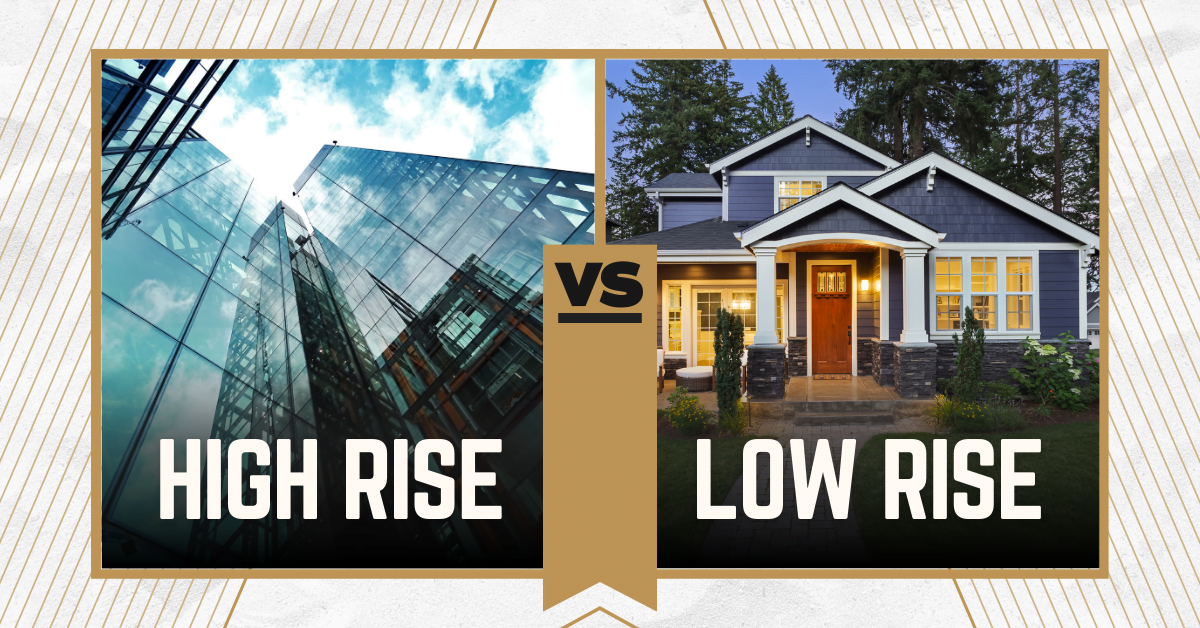High-Rise vs. Low-Rise Apartments: Who Should Choose a High-Rise Home?
When it comes to buying a home, many homebuyers face the dilemma of choosing between a high-rise apartment and a low-rise floor. While both options have their merits and are sold in equal quantities, the decision ultimately depends on the specific needs and preferences of the buyer and their family. In this article, we will focus on the first part of the question: who should buy a house in a high-rise apartment? We will explore ten key points that shed light on the advantages of high-rise living and help you determine if it’s the right choice for you.
Understanding High-Rise and Low-Rise Buildings
Before delving into the specific points, let’s clarify the definitions of high-rise and low-rise buildings according to the Indian Building Code:
- Low-Rise Building: A building below 15 meters in height, typically consisting of ground plus four stories, with one house per floor, one lift, and one staircase.
- High-Rise Building: A building above 15 meters in height, with more than four floors.
- Low-Rise Floor: A low-rise building within a gated project or community.
- Builder Floor: A low-rise building in a sector or non-gated location, such as a licensed colony.
10 Points in Favor of High-Rise Apartments
- Multi-Tier Security:
- High-rise projects offer an additional layer of security, with guards stationed under each tower to monitor and record visitors.
- This extra security provides peace of mind, especially for deliveries and service personnel.
- Safety:
- High-rise buildings typically feature a layout with towers on the outer circle and a central green area, creating a no-car zone.
- This design allows children and senior citizens to safely access the clubhouse and play areas without vehicular contact.
- Access to Clubhouse and Basic Conveniences:
- In high-rise projects, the clubhouse is usually located in the central no-vehicle zone, making it easily accessible by foot.
- Low-rise projects often have larger land parcels, resulting in the clubhouse being further away and requiring a vehicle to reach.
- View:
- High-rise apartments offer the option to choose between a green view inside the society or a city view from higher floors.
- Low-rise floors have limited view options, typically restricted to the front of the house.
- Sunlight and Ventilation:
- High-rise apartments provide more options for sunlight and ventilation, with the ability to choose doors with two or three sides open.
- Low-rise floors have limited sunlight and ventilation options due to the proximity of neighboring houses.
- Privacy:
- High-rise apartments allow buyers to choose the distance between their building and the one in front, ensuring privacy.
- Low-rise floors have houses in close proximity, compromising privacy, especially in back portions and bedrooms.
- Construction Quality:
- High-rise buildings are constructed using modern technologies like MyOne, which is a purely RCC structure considered superior to older methods.
- Low-rise floors are typically built using traditional materials like red brick or ash brick, which may not be as advanced as high-rise construction techniques.
- Basic Amenities:
- High-rise apartments often feature multiple lifts, including a service elevator, providing backup options in case of breakdowns.
- Low-rise floors usually have a single lift, which can be problematic if it malfunctions, especially for those with mobility issues.
- Maintenance:
- High-rise apartments have designated parking areas, either in the basement or outside the tower, minimizing the impact of littering by individual residents.
- Low-rise floors have stilt parking, where littering by a single resident can negatively affect the living experience of others, and addressing the issue can be challenging.
- Resale Value:
- Historical data suggests that high-rise apartments tend to appreciate slightly more in value compared to low-rise floors.
- While there may be exceptions, the overall trend favors high-rise apartments in terms of capital appreciation.
Who Should Buy a House in a High-Rise Apartment?
Based on the ten points discussed, the following types of buyers should consider purchasing a home in a high-rise apartment:
- Families with small children or elderly parents who prioritize safety and security.
- Individuals with traveling jobs who frequently leave their families alone at home.
- People who value personal space and privacy, requiring separate balconies for different rooms.
- Those with hectic lifestyles who seek peace of mind, better air quality, and reduced noise pollution by living on higher floors.
Conclusion
While both high-rise and low-rise apartments have their advantages, high-rise living offers specific benefits that cater to certain lifestyles and family structures. The enhanced security, safety, access to amenities, privacy, construction quality, and resale value make high-rise apartments an attractive choice for many homebuyers. However, it’s essential to note that low-rise apartments also have their own unique advantages, which will be discussed in the next video. Ultimately, the decision to buy a house in a high-rise or low-rise apartment should be based on a thorough evaluation of your personal needs, preferences, and family requirements.
A high-rise building is defined as a structure that is more than 15 meters in height and has more than four floors.
Unlock Your Dream Home Today!
Get personalized real estate insights delivered straight to your inbox.
High-rise projects provide multi-tier security, including guards stationed under each tower to monitor and record visitors, enhancing safety for residents.
High-rise buildings are designed with a no-car zone, allowing safe access for children and senior citizens to the clubhouse and play areas without vehicular traffic.
High-rise apartments typically feature access to a clubhouse, multiple lifts, and other basic conveniences, all usually located within a central no-vehicle zone.
Yes, high-rise apartments provide options for both green views inside the society and city views from higher floors, while low-rise apartments have limited view options.
High-rise apartments offer more options for sunlight and ventilation due to their design, while low-rise floors may have restricted sunlight and ventilation because of neighboring buildings.
High-rise buildings are often constructed using modern techniques and materials, such as MyOne RCC structures, which typically offer superior quality compared to traditional low-rise construction methods.
High-rise apartments have designated parking areas that reduce littering issues, while low-rise floors often have stilt parking, which can be negatively affected by individual residents' actions.
High-rise apartments are ideal for families with small children or elderly parents, individuals with traveling jobs, people who value privacy, and those seeking peace of mind in a hectic lifestyle.
Historical data indicates that high-rise apartments generally appreciate more in value than low-rise floors, making them a potentially better investment over time.
DISCLAIMER
The information provided on this website is for general informational purposes only. While we strive to keep the content up-to-date and accurate, we make no representations or warranties of any kind, express or implied, about the completeness, accuracy, reliability, suitability, or availability of the information, products, services, or related graphics contained on this website.
In no event will we be liable for any loss or damage including without limitation, indirect or consequential loss or damage, or any loss or damage whatsoever arising from loss of data or profits arising out of, or in connection with, the use of this website.
Real Estate Investment Risks
Real estate investments involve significant risks and market volatility. Property values, rental rates, and market conditions can fluctuate. Past performance is not indicative of future results.
Before Making Real Estate Decisions
Before making any real estate decision, we strongly advise you to:
- Conduct thorough due diligence
- Consult with qualified legal, financial, and real estate professionals
- Carefully review all relevant documents and contracts
- Consider your personal financial situation and investment goals
This website does not provide legal, financial, or investment advice. All content is for informational purposes only and should not be construed as professional advice or recommendations.
By using this website, you acknowledge and agree to these terms. We reserve the right to modify this disclaimer at any time without notice.







